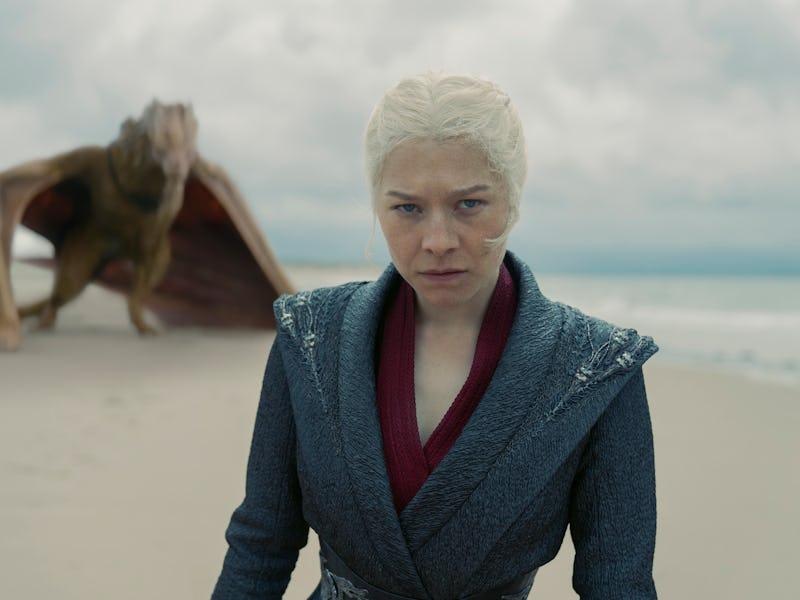House of the Dragon is Doing With Rhaenyra What Game of Thrones Failed With Daenerys
The “Mad Queen” has returned.

A good prequel typically has the benefit of hindsight. It’s mostly tasked with setting up a much larger story, but it also (sometimes) has the power to retroactively fix its predecessor’s biggest mistakes. We’ve seen some of that on this season of House of the Dragon, which feels more connected to its parent show, Game of Thrones, than it ever was in Season 1. Try as it might, though, it can’t actually fix Thrones and its disappointing final season — but it does know how to repurpose the themes and ideas that never truly got the chance to pan out properly.
The series takes one of Thrones’ biggest missed opportunities — the prophecy of the Prince that was Promised — and uses it to contextualize the conflict between its two Targaryen factions. Known to the House as the Song of Ice and Fire, this prophecy is basically the very thing that starts the Dance of Dragons. As Rhaenyra Targaryen strives to justify an inevitable bloodshed, she leans on this prophecy more and more. By the time Season 2 comes to an end, she wholeheartedly believes her cause is righteous.
Warning: Spoilers for House of the Dragon Season 2’s finale follow!
Rhaenyra’s newfound savior complex brings House of the Dragon to some admittedly dark places, but what makes her turn so interesting is the way it seems justified by the narrative itself. The Song of Ice and Fire has become the perfect excuse for any choice, including the murder of innocents.
From gathering the Targaryen bastards hoping to bond with a dragon in Episode 7, to all the potential casualties in future episodes, Rhaenyra is earning her reputation as the Black Queen. But each of her “sacrifices” are framed sympathetically at every turn: She has no choice but to unleash these horrors. In fact, she’s doing them in service of a greater threat. And the crazy thing is, destiny seems to be on her side. It’s a far cry from the last Targaryen woman we watched fight for the Iron Throne, Daenerys Targaryen, and her own botched corruption arc.
A lot of fans saw Daenerys’ “Mad Queen” arc comic, but it’s still one of Thrones’ worst developments.
It’s impossible not to watch Rhaenyra embark on her crusade without thinking of Daenerys Targaryen. These two aspiring queens don’t have all that much in common, but their ambitions are each rooted in two different brands of fanaticism. Rhaenyra’s newfound religious fervor guides her every step: it’s the only thing keeping her going after she’s usurped by her half-brother Aegon. Daenerys, meanwhile, is frequently torn between her more violent tendencies and her sense of justice. Early seasons of Game of Thrones framed her as a protector of the innocent; that’s what makes her major heelturn at the end of the series (y’know, when she burns all those innocent people at King’s Landing) such a betrayal for her character.
There’s nothing inherently wrong with the idea of “Mad Queen” Dany — at least, not on paper. The signs of her corruption were there, for those who knew where to look. But there’s something to be said for how quickly Game of Thrones positioned the character from savior to oppressor. Dany’s descent into “madness” transpires within a handful of episodes, and totally undoes all of her development across Thrones’ eight seasons. The series resorts to cheap tropes about power-hungry, hysterical women, throwing away her humanity as soon as it’s convenient. Her turn could have been one of the best developments in the series; instead, it became one of the most egregious character assassinations ever.
Rhaenyra is working overtime to justify her right to rule, and it’s one of House of the Dragon’s most important character choices yet.
House of the Dragon clearly learned from Thrones’ mistakes: it takes a similar set-up with Rhaenyra, but completely reframes it within the narrative. Rhaenyra desperately wants to end this conflict with as little bloodshed as possible, but she knows that she and her dragonriders will have to stand against her enemies and weaken them where they can. That means that innocents will be sacrificed — but hopefully in the service of something more important than a crown. It’s a natural character progression for Rhaenyra that is embodied by the scene in the Season 2 finale when she orders her new dragonriders on a mission to take Oldtown and Lannisport, at the cost of thousands of innocent lives.
House of the Dragon suggests that, if Rhaenyra sits on the Iron Throne, the Seven Kingdoms can successfully unite against the endless Winter we see in Game of Thrones. The Song of Ice and Fire informs Rhaenyra’s every move... but those who watched that prophecy play out in Game of Thrones know that it doesn’t really matter in the end.
Those familiar with Rhaenyra’s fate also know that the Dance of Dragons won’t end well for her. This sets up some major tension for audiences in the know. No matter what, Rhaenyra is basically doing all of this for nothing. It sets her up as a Mad Queen in another sense: one that could doom the entire realm trying to secure her divine right. Unlike Daenerys’ rushed corruption arc, however, House of the Dragon is taking its time to build Rhaenyra up before pulling her down.